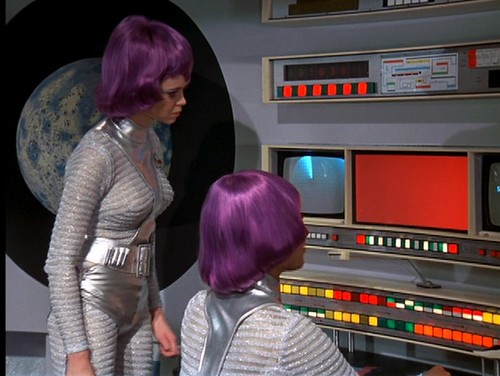Recently, author Charlie Stross posted the transcript of a talk he gave to a tech consultancy titled “Shaping the Future” . It’s worth reading in it’s entirety; if you click through please remember to come back – I have some thoughts I’d like to share.
A side trip on our way to the meat of the matter… Stross identifies bandwidth – the ability to move information from place to place – as a key variable. It’s one of those things that’s getting faster, faster (think exponential increase). I want to recommend The Victorian Internet – a book that looks at the beginning of the communications revolution. Before the telegraph, information moved at the same rate people did – as fast as a horseback messenger or a clipper ship. The telegraph was an enormous change – one that left fingerprints that we see to this day. Baud – the speed measurement applied to modems (themselves becoming obsolete) – is named for Émile Baudot, a pioneer in the field. There are other examples; I’ll leave the rest to The Victorian Internet.
– a book that looks at the beginning of the communications revolution. Before the telegraph, information moved at the same rate people did – as fast as a horseback messenger or a clipper ship. The telegraph was an enormous change – one that left fingerprints that we see to this day. Baud – the speed measurement applied to modems (themselves becoming obsolete) – is named for Émile Baudot, a pioneer in the field. There are other examples; I’ll leave the rest to The Victorian Internet.
The focus of Stross talk is the notion of lifeblogging:
Today, I can pick up about 1Gb of FLASH memory in a postage stamp sized card for that much money [ten euros]. fast-forward a decade and that’ll be 100Gb. Two decades and we’ll be up to 10Tb.
10Tb is an interesting number. That’s a megabit for every second in a year — there are roughly 10 million seconds per year. That’s enough to store a live DivX video stream — compressed a lot relative to a DVD, but the same overall resolution — of everything I look at for a year, including time I spend sleeping, or in the bathroom. Realistically, with multiplexing, it puts three or four video channels and a sound channel and other telemetry — a heart monitor, say, a running GPS/Galileo location signal, everything I type and every mouse event I send — onto that chip, while I’m awake. All the time. It’s a life log; replay it and you’ve got a journal file for my life. Ten euros a year in 2027, or maybe a thousand euros a year in 2017. (Cheaper if we use those pesky rotating hard disks — it’s actually about five thousand euros if we want to do this right now.)
Why would anyone want to do this?
I can think of several reasons. Initially, it’ll be edge cases. Police officers on duty: it’d be great to record everything they see, as evidence. Folks with early stage neurodegenerative conditions like Alzheimers: with voice tagging and some sophisticated searching, it’s a memory prosthesis.
Add optical character recognition on the fly for any text you look at, speech-to-text for anything you say, and it’s all indexed and searchable. “What was the title of the book I looked at and wanted to remember last Thursday at 3pm?”
Think of it as google for real life. *
We’re seeing the beginnings of something like this today. My blog is not the only way I share information about what I’m up to and what I’m thinking – there’s also my Flickrstream (interesting word that was invented to describe people’s photo repositories, eh?), Twitter (short term, ephemeral stream of consciousness stuff), del.icio.us (public list of my bookmarks), and email (more – presumably – private). Others may add YouTube or other video services to the list and I’m sure there are many other bits of software I’m missing; I have little or no MySpace/Facebook knowledge, for example.
All this is fine as I wander around documenting what I want to document, writing what I feel like writing. But (there’s always a but), here comes Monty! Who is Monty, you ask? He is the cat in the window. A new feature of Google Maps provides street level zooms for select urban areas – the Google folks have vehicles driving around cities taking pictures. When the Google car came by, Monty was sitting in his normal perch. Later, when Google rolled out the new feature, Monty’s owner took a look at her neighborhood, saw her cat in her window, and got a little – understandably in my book – freaked. Ms. Kalin-Casey – one of Monty’s owners – writes,
The question is, where do we draw the line between public and private? Obviously, the picture of Monty isn’t very good, but who’s to say whether tomorrow, Google’s camera’s won’t be a lot better, giving clearer pictures and more detail? I’ve already seen one post online where the poster’s only complaint about Google pics is that the pictures aren’t sharp enough. (He wasn’t commenting on my pic, but on a picture of his own home.)
The opposing argument claims that what’s visible from the street is public. By opening my windows for some much-needed light and air, am I granting permission for my living room to be broadcast worldwide? I don’t think I am. I think if I open my windows, my neighbors and passers by might see the cat in the window. That’s substantially different to me than realizing that everyone in the world can potentially see into my home.
It’s my feeling that we should know what kind of monitoring we’re subject to and when. Stores, airports, intersections, museums —there are security cameras everywhere. We’ve all seen overhead satellite photos for mapping purposes, but when does helpful mapping recon morph into home surveillance? When does it move from a grainy picture of the cat to a high-res image where you can see small details in my apartment? When do I have to choose between sunlight and unseen threats to privacy? *
Think about those sorts of reasonable concerns in a world where everything I see or hear, I record. I think jammer technologies will get hot, but regardless, our notions of privacy will need to be sharpened and thought through a little more thoroughly than they are today. I don’t have answers; I probably am not even seeing the real questions – we ought to start paying some attention though. As William Gibson said, “The future is here. It’s just not widely distributed yet.”








